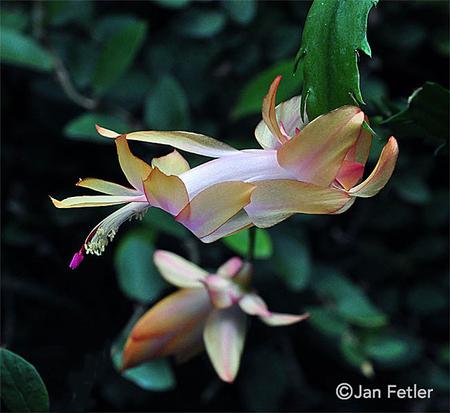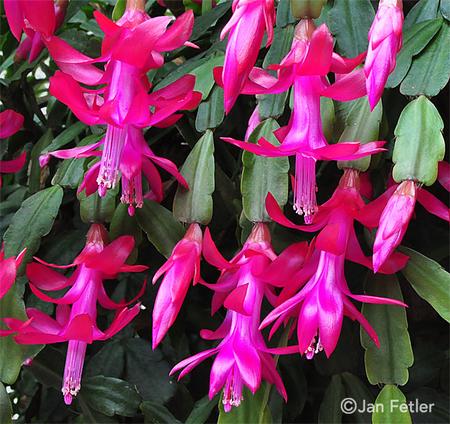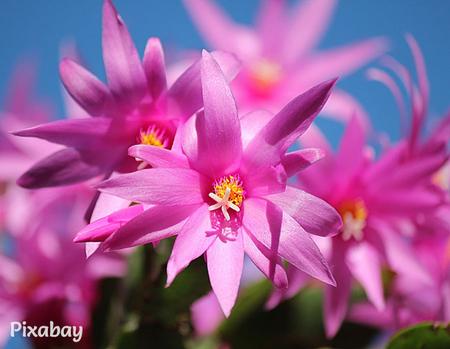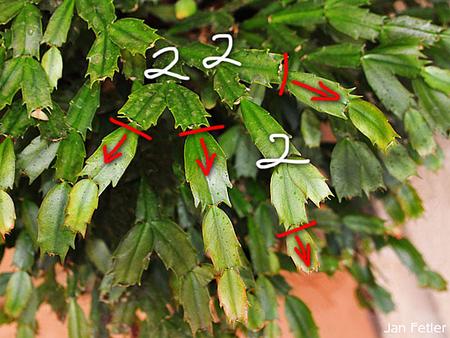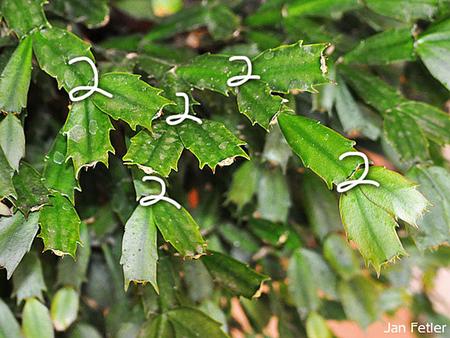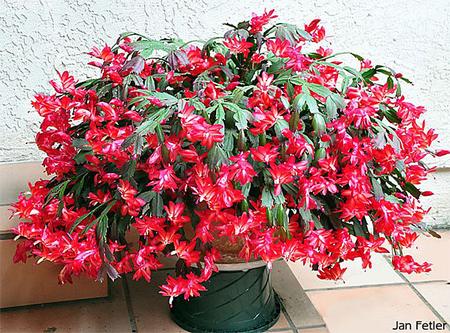Christmas cactus
Home » Container gardening resources » Christmas Cactus
There are 2 Schlumbergera varieties that bloom in late fall. Both are often called Christmas Cactus.
The plant most folks grow is actually a Thanksgiving cactus (Schlumbergera truncata). It blooms in many colors and usually begins blooming in November. Flowers are held horizontally or tipped upward, and leaf segments are serrated with soft, pointed edges. Hybridizers are working on yellow varieties like ‘Christmas Flame’ displayed here.
Schlumbergera truncata, Thanksgiving cactus
The "real" Christmas cactus (Schlumbergera buckleyi) is similar but usually blooms in December or later. The color is hot pink (only) with flowers hanging in a pendulous fashion. Leaf segment edges are rounded.
Schlumbergera buckleyi Christmas cactus
There is another similar plant. The Easter cactus (officially Hatiora gaertneri, but often offered as Rhipsalidopsis gaertneri or Schlumbergera gaertneri) that blooms in spring. Flowers come in many colors, but with a single whorl of petals, they are shaped more like daisies. Leaf segment edges are rounded. Culture instructions are similar to the two above, but check online for more details.
Hatiora gaertneri Easter Cactus
General culture for Schlumbergera truncata and buckleyi
Plants bloom best when roots are crowded and when they live outdoors spring through fall. Shortening days and cooler temperatures signal plants to set flower buds. Give them plenty of light but no direct sun. Outdoors, choose a location on the north side of a fence or building. Indoors, a sheer curtain that blocks direct sun works for most exposures.
Plants are very hardy and have virtually no pests. Over-watering is the biggest threat to their health. They are succulents and can store some water in their leaves. Water when the soil surface is dry but not more than about once a week. They should never sit in a pool of water.
Red leaves are a sign of stress. In some cases, just a heavy bloom can be the stressor—as in the blooming plant pictured at the end of this post. Other common causes include too much sun/sunburn and over-watering. If the plant looks doomed with shriveled, drooping leaves, take some cuttings and propagate according to instructions below.
Repot in spring when plants begin active growth, but think "root bound" for best blooming. Any good potting soil will do. Spring is also a good time for some all-purpose fertilizer. Go easy on fertilizer.
Propagate by twisting off leaf branches. Shorten cuttings to the newest three to five leaves. Put cutting in water to cover the lowest leaf by half. Roots will form on the end resting on the bottom of the jar. You can also propagate in pots. In that case, allow the cuttings to sit on a shelf for a day or two to “callus” the cut end. Place cuttings in fresh potting soil, water and cover with a plastic bag to maintain moisture. Use of rooting powder may speed the rooting process, but is not necessary.
To bathe, spray the plant with a hose to clean off the summer dirt. Then mix mild liquid soap (Castile is best or use insecticidal soap) with water and spray the wet leaves. Water beads dissolve and the plant will dry to a lovely sheen. This bathing method works for most houseplants.
Garden centers and even grocery stores have plants by November. They have been growing under ideal greenhouse conditions so don't be surprised if buds/flowers drop when you get them into your home. They will adapt for future years.
Pruning instructions
Pruning is simply shortening long chains of leaves. While it is not necessary for plant health, it will keep the plant compact and force blooms into a smaller area.
Thanksgiving and Christmas cactus are pruned the same way and time of year. Do this at the end of the growth cycle and before flower buds set. Usually late summer/early September.
Ideally you would remove leaves back to where 2 leaves come out of a single leaf as shown in the photo below (2s indicate places where 2 leaves emerge. Red slashes = CUT. Red arrows = THIS).
If you have never pruned, this approach will seem radical. You can begin by shortening long chains of leaves by half.
If your plant has already set flower buds, wait to prune till spring or next fall.
Below is the finished pruning. No more chains of single leaves. It will soon begin setting buds for another spectacular show. Now this dirty plant needs a bath! See the bathing instructions above.
Pruning in September not only keeps the plant compact but forces the blooms into a smaller area for a bigger show—sometimes making 2 buds per leaf. The plant pictured is about 15 years old in the original pot. It is a Thanksgiving Cactus (Schlumbergera truncata) and lives in a protected area outside year around. Photo taken in late November.
November 8, 2022. Written by Jan Fetler, UCCE Master Gardener of Sacramento County.




